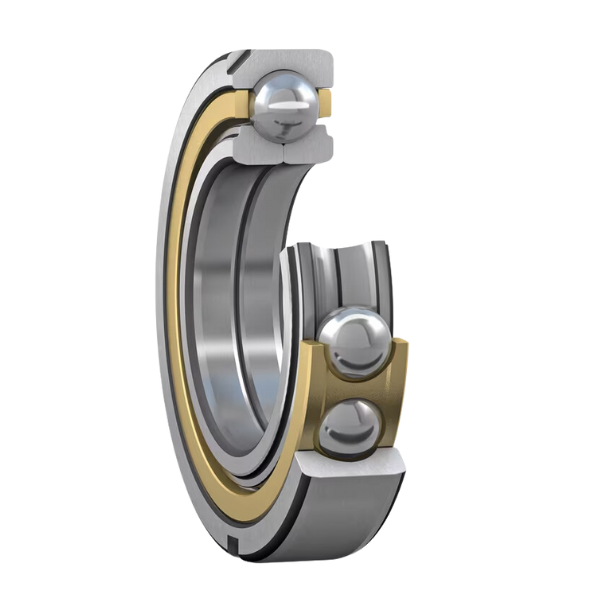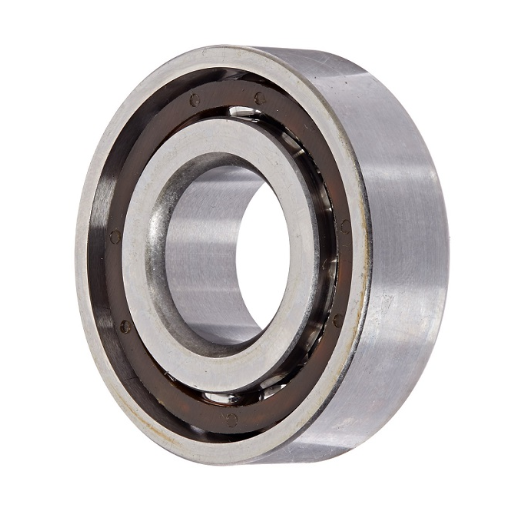Four-Point Contact Ball Bearings
Home » Four-Point Contact Ball Bearings
-
Understanding Four-Point Contact Ball Bearings
AMIGO’s Four-Point Contact Ball Bearings can carry radial and axial loads with great accuracy and high efficiency. They provide a unique construction capable of carrying axial loads even in both opposite directions. They are hence beneficial when there is limited space, and more load has to be taken. One of the notable aspects of AMIGO bearings is that they are interchangeable with other leading brand bearings, such as those manufactured under the brands SKF, FAG, and NSK.

Features and benefits
- Less axial space: These bearings take up considerably less than double-row bearings.
- High load-carrying capacity: Many balls are incorporated, giving the bearing a high capacity.
- Separable design: The split inner ring leads to easier mounting and dismounting of the bearing.
Temperature Limits
The permissible operating temperature for four-point contact ball bearings can be limited by:
- Dimensional stability of the bearing rings and balls
- Cage
- Lubricant
The bearings are heat stabilized up to at least 150 °C (300 °F).
Applications
- Automotive Industry: Utilized in gearboxes and transmissions to manage axial loads in compact spaces, ensuring smooth and efficient power transfer.
- Energy Sector: Used in wind turbine generators and other renewable energy systems to handle axial loads efficiently, ensuring stable operation.
- Marine Industry: Applied in ship steering mechanisms and propeller shafts to manage axial forces in confined spaces.
Four-Point Contact Ball Bearings Size Chart
| Designation | Principal dimensions | Bearing Dimensions Chart Pdf | ||
|---|---|---|---|---|
| d[mm] | D[mm] | B[mm] | ||
| 7006 BXL 2RS TVP | 30 | 55 | 26 | Download |
| 7007 BXL 2RS TVP | 35 | 62 | 14 | Download |
| 7201 BXL 2RS TVP | 12 | 32 | 10 | Download |
| 7202 BXL 2RS TVP | 15 | 35 | 11 | Download |
| 7205 BXL2RSTVP | 25 | 52 | 15 | Download |
| 7206B 2RS | 30 | 62 | 16 | Download |
| 7207 BECBP | 35 | 72 | 17 | Download |
| 7305 BECBP | 25 | 62 | 17 | Download |
| 7306 BECBP | 30 | 72 | 19 | Download |
| 7307 BECBP | 35 | 80 | 21 | Download |
Customize bearings to meet your specific needs
Looking for bearings tailored to your unique specifications? Our customization service ensures that each bearing is designed and manufactured to meet your exact requirements, providing the perfect solution for your application. Click the "Enquire Now" button to discuss your needs with our experts and get started on your custom bearing solution today.
Four-Point Contact Ball Bearing - Designs and Variants
The SKF standard assortment of four-point contact ball bearings includes:
- Bearings in the QJ 2 and QJ 3 series
- Some sizes in the QJ 10 and QJ 12 series
Four-point contact ball bearings can be supplied with two locating slots in the outer ring:
- Preventing the bearing from turning
- Positioned 180° apart
Four-Point Contact Ball Bearings Loads
Minimum Load
In bearing applications, ensuring that the bearings are subjected to a minimum load is crucial for avoiding damage due to slippage or skidding, especially in high-speed operations.
Maintaining this minimum load is vital to ensure that the rolling elements do not slip, which can cause premature bearing failure.
Equivalent Bearing Loads
The Equivalent Dynamic Bearing Load (P) is essential for determining how the bearing will perform under dynamic conditions, which involves both radial and axial loads. The calculation depends on whether the bearing is a locating bearing or a thrust bearing.
Designation System for Four-Point Contact Ball Bearings
The designations of most AMIGO rolling bearings follow a system that may consist of a basic designation with or without one or more prefixes and/or suffixes.
| Category | Code | Description |
|---|---|---|
| Suffixes - Cage design | FA | Machined steel cage, outer ring centred |
| MA | Machined brass cage, outer ring centred. | |
| PHAS | Glass fibre reinforced PEEK cage, with lubrication grooves in the guiding surface, outer ring centred | |
| Suffixes - Accuracy, clearance, preload, quiet running | P6 | Dimensional and geometrical tolerances (tolerances of run-out) to class P6 |
| P62 | P6 + C2 | |
| P63 | P6 + C3 | |
| P64 | P6 + C4 | |
| P6CNL | P6 + CNL | |
| CNL | Axial internal clearance in the lower half of the Normal range | |
| C2 | Axial internal clearance smaller than Normal | |
| C2H | Axial internal clearance in the upper half of the C2 range | |
| C2L | Axial internal clearance in the lower half of the C2 range | |
| C3 | Axial internal clearance greater than Normal | |
| C4 | Axial internal clearance greater than C3 | |
| 344524 | C2H + CNL | |
| Suffixes - Other variants | 309829 | Larger balls |

Four-Point Contact Ball Bearing Catalogue
Explore our comprehensive Single Row Cylindrical Roller Bearing Catalogue in PDF format, featuring detailed specifications, dimensions, and performance data for AMIGO bearings. This catalogue is essential for selecting the right bearing for your application, offering full interchangeability with leading brands like SKF, SIGMA, NSK, CRAFT, and FBJ. Download the PDF to access all the information you need to decide on our high-quality, durable bearings.
General bearing specifications
| Specification | Details |
|---|---|
| Dimension standards | Boundary dimensions: ISO 15 |
| Locating slots: ISO 20515 | |
| Tolerances | Normal |
| P6 run-out on request | |
| SKF Explorer bearings: | |
| P6 | |
| Values | ISO 492 |
| Internal clearance | Normal |
| Check availability of C2, C3, C4 or reduced ranges of standard clearance classes | |
| Values | ISO 5753-2 |
| Misalignment increases bearing noise and reduces bearing service life, and when it exceeds the guideline values, these effects become particularly noticeable. | |
| Friction (starting torque, power loss) | Use |
| Defect frequencies | Use |
Explore More on Bearings


Frequently Asked Question
Q: What are Four-Point Contact Ball Bearings?
A: Four-point contact ball bearings are a type of angular contact ball bearing primarily meant for axial load in both directions and for support of radial loads within a reasonable bearing.
Q: How do Four-Point Contact Ball Bearings work?
A: These bearings produce a divided inner ring, so there is no need to have two bearings to support axial loads in two opposite directions.
Q: What are the advantages of using Four-Point Contact Ball Bearings?
A: Some of the core benefits of the above-mentioned are reduction of space, high load capacity, and replacing the two angular contact bearings with one, making the design more accessible and cost reduction.
Q: In which applications are Four-Point Contact Ball Bearings commonly used?
A: These are frequently used in the places such as gearboxes, control devices in aerospace engineering, industrial machines, medical instruments and so on where handling of axial load is essential.
Q: Are Four-Point Contact Ball Bearings suitable for high-speed applications?
A: They can withstand moderate speed but typically are more suited for cases where the ability to withstand an axial load is more important than the ability to achieve a high speed.
Q: Four-point Contact bearings vs. other ball bearings, how interchangeable are the fore-point contact ball bearings?
A: Yes, in many applications, they can often be replaced by two angular contact bearings, which makes them more compact and cost-effective.
Q: What are the four-point contact ball bearing and angular contact ball bearing differences? What are the most salient ones?
A: When comparing Four-Point Contact Ball Bearings to conventional angular contact bearings, the key variation is that a single Four-Point Contact Ball Bearing can take up axial loads with dual support, unlike a layout with angular contact bearings, where the loads are supported in one direction.
Q: What is the procedure for maintaining the Four Point Contact Ball Bearings?
A: Their wearing-in and overhauling require regular lubrication and inspection, maintenance required in heavy-duty operations. Furthermore, the correct position is essential when installing the bearings.
Q: What parameters should be evaluated before going for Four-Point Contact Ball Bearings?
A: The parameters to be assessed include the required load capacity, operating speed, a design restraint aspect, and the environment in which the application will take place.
Q: Is it possible to find four-point contact ball bearings of different dimensions and manufacturing materials?
A: Yes, they can be provided in various sizes, materials, and designs according to the application requirements to enhance their performance and service life.


